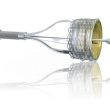Original Title: Transcatheter Aortic Valve Replacement versus Surgical Valve Replacement in Intermediate-Risk Patients: A Propensity Score Analysis. Reference: Vinod H Thourani et al. Lancet Published Online April 3, 2016. Courtesy of Dr. Carlos Fava. The transcatheter Aortic Valve Replacement (TAVI) has shown benefits in high risk patients or inoperable patients, but there is little evidence<a href="https://solaci.org/en/2016/04/13/tavi-good-outcomes-with-intermediate-risk/" title="Read more" >...</a>
New York TAVR Registry: Trends in use and mortality at one year
Original Title: Utilization and 1-Year Mortality for Transcatheter Aortic Valve Replacement and Surgical Aortic Valve Replacement in New York Patients With Aortic Stenosis2011 to 2012. Reference:Hannan EL et al. J Am CollCardiolIntv. 2016;9(6):578-585. Courtesy of Dr. Agustín Vecchia It’s been only 14 years sinceCribierperformed the first transcatheter valve replacement. Today, during 2016, 100,000 patients are expected to<a href="https://solaci.org/en/2016/04/08/new-york-tavr-registry-trends-in-use-and-mortality-at-one-year/" title="Read more" >...</a>
PARTNER 2A: TAVI Not Inferior to Surgery in Intermediate Risk Patients
Transcatheter aortic valve replacement (TAVI) with the new generation balloon expandable valve is at least as good as surgery in intermediate risk patients with severe symptomatic aortic stenosis. For those that can be accessedfemorally, TAVI seems even better than surgery. In all, 2032 intermediate risk patients were randomized in 57 centers to TAVI with Sapien<a href="https://solaci.org/en/2016/04/08/partner-2a-tavi-not-inferior-to-surgery-in-intermediate-risk-patients/" title="Read more" >...</a>
CoreValve US Pivotal: at 3 Years, the Self-Expanding Valve Maintains Its Advantage vs. Surgery
At 3 year follow up, the CoreValve US Pivotal study on high risk elderly patients, the self-expanding valve showed a lasting benefit vs. surgery. These findings could suggest that the self-expanding valve should be considered the preferred treatment in patients with symptomatic severe aortic stenosis at increased risk for surgery. The study included 797 patients<a href="https://solaci.org/en/2016/04/08/corevalve-us-pivotal-at-3-years-the-self-expanding-valve-maintains-its-advantage-vs-surgery/" title="Read more" >...</a>
PARTNER 1 in +90 Year Old Patients: TAVI and the Age Paradox
A new analyzis of the PARTNER 1 trial showed that patients over 90 undergoing transcatheter aortic valve replacement (TAVI) show no increase in mortality or major cardiovascular events rates, compared to younger patients. In fact, patients over 90 undergoing TAVI have the same life expectation of someone the same age with no aortic stenosis. In-hospital<a href="https://solaci.org/en/2016/04/08/partner-1-in-90-year-old-patients-tavi-and-the-age-paradox/" title="Read more" >...</a>
The largest series with LOTUS Valve published so far
This work represents the UK experience with the second generation repositionable and retrievable valve Lotus (Boston Scientific, Natick, Massachusetts). It prospectively included 228 patients of mean age 81.4 ± 7.6 and a logistic EuroScore of 17.5 ± 12.4. From the total number of patients, 187 (82%) received the valve for aortic stenosis, 7<a href="https://solaci.org/en/2016/03/08/the-largest-series-with-lotus-valve-published-so-far/" title="Read more" >...</a>
One year outcomes of the new repositionable and retrievable valve
Original Title: 1-Year Outcomes with the Fully Repositionable and Retrievable Lotus Transcatheter Aortic Replacement Valve in 120 High-Risk Surgical Patients with Severe Aortic Stenosis Results of the REPRISE II Study. Reference: Ian T. Meredith et al. J Am Coll Cardiol Intv. 2016;9(4):376-384. This analysis represents the first report at one year of 120 patients enrolled<a href="https://solaci.org/en/2016/02/23/one-year-outcomes-of-the-new-repositionable-and-retrievable-valve/" title="Read more" >...</a>
TAVI in patients older than 90: similar outcomes to those obtained in younger patients
Original title: Comparison of Outcomes of Transcathether Aortic Valve Implantation in Patients ≥90 Years Versus <90 Years. Reference: Yigal Abramowitz, et al. Am J Cardiol 2015;116:1110-1115. More and more 90 year old patients require transcatheter aortic valve replacement (TAVI); however, its benefits have not been studied in this particular population. This study enrolled 734 patients<a href="https://solaci.org/en/2015/11/16/tavi-in-patients-older-than-90-similar-outcomes-to-those-obtained-in-younger-patients/" title="Read more" >...</a>
SAPIENS 3: Favorable outcomes with TAVI in intermediate risk patients
Transcatheter aortic valve replacement is a safe and effective alternative to surgery in patients with severe aortic stenosis and high surgical risk as the 5-year results of PARTNER 1 Alternate showed. The aim of this study was to evaluate the result of the Edwards Sapien 3 valve in patients with severe aortic stenosis and intermediate<a href="https://solaci.org/en/2015/06/24/sapiens-3-favorable-outcomes-with-tavi-in-intermediate-risk-patients/" title="Read more" >...</a>
NOTION: TAVR in low-risk patients
The aim of this study was to compare the results of transcatheter aortic valve replacement (TAVR) versus surgery in unselected patients with severe degenerative aortic stenosis. Patients were randomized 1:1 to TAVR (n = 145) or surgical replacement (n = 135). Those of TAVR group received Medtronic CoreValve self-expanding valve. The femoral access was used<a href="https://solaci.org/en/2015/06/24/notion-tavr-in-low-risk-patients/" title="Read more" >...</a>







